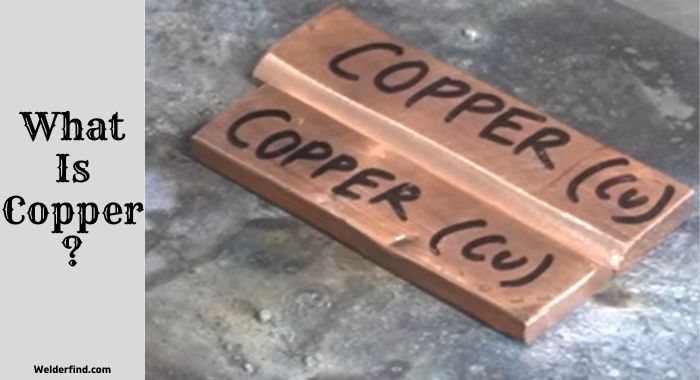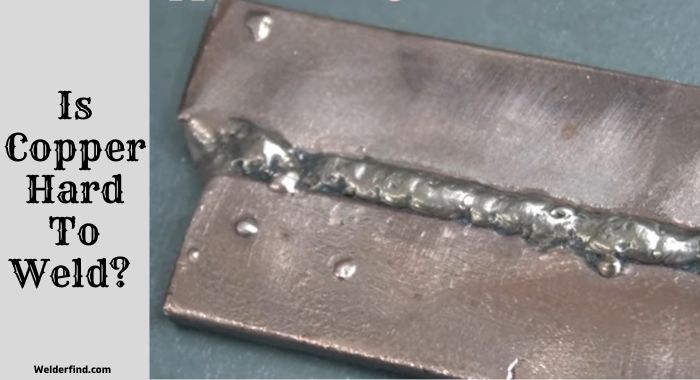Undoubtedly, stick welding is a versatile welding process, which you can apply for welding multiple applications at once. But can you stick weld copper?
This question may knock your brain because copper welding differs from different size steel welding or aluminum welding.
So, find out the answer right here-
What Is Copper?

In simple terms, copper is known to be a chemical element combining red and gold colors. Coming in a symbol of “Cu,” you’ll find it malleable, flexible, and relatively soft.
Among the vast collections of metals, copper is considered one of the most used elements these days for being versatile.
Is Copper Hard to Weld?

Put a smile on your face, as copper welding isn’t a difficult task. For the process, you need to confirm the produced heat required for the welding is double the steel.
This is because copper incorporates relatively more thermal conductivity.
Can You Stick Weld Copper?
Stick welding, also known as MMA (manual metal arc welding), that is used by many seasoned and intermediate welders. This welders try to use intermediate stick welders to weld copper or such materials.
As for the rods, an electrode of phosphor bronze, ECuSn-C, with a combination of aluminum, Tin, and ferrous phosphorous, is suitable for joining copper with other materials.
Can You Stick Weld Copper to Mild Steel?
To ensure leakage-free bonding, you can rely on your stick welding without thinking twice about welding copper to mild steel.
After choosing the flat position, make sure you start MMAW using suitable electrodes, proper gases (if required), and other essential components.
Can You Stick Weld Copper to Aluminum?
Just like welding copper to mild steel, it’s equally possible to weld copper to aluminum. You must know the current settings and electrodes and choose a suitable spot.
Thus, you can go through the steps without any risks and hassles.
Can You Stick Weld Copper to Cast Steel?
Although EBW (Electron Beam Welding) is an ideal welding process to weld copper to cast steel, it won’t be wrong if you choose MMAW instead of EBW.
Since cast steel tends to be superior compared to aluminum in terms of strength, you may need to use extra heat to weld thoroughly.
Can You Stick Weld Copper to Stainless Steel
Yes, you can stick weld copper to stainless steel, like welding cast steel. That said, it’s necessary to note that stick welding stainless steel tends to be a bit different from cast steel as it is lighter than cast steel,
which is why there is a high chance of ending up with melted steel in case you use excess heat than usual.
How to Weld Copper Using Stick Welding
From welding preparation to the finishing, I’ll discuss everything to let you learn how to stick-weld copper in the best way possible –
Preparation before Welding
It’s a must to get a specific cleaning agent and a piece of steel brush. With their assistance, you can clean the surface of copper workpieces by eliminating dirt, grease, paint, oil, and such things.
After that, pay attention to preheating the workpiece, depending on the thickness of the metal base. But as a rule of thumb, you’ll have to rely on around 50 – 750 Degrees Fahrenheit.
If you rely on preheating, you won’t have to use high amperage during a weld. Thus, it ensures cost-efficiency as well.
Last but certainly not least, proper ventilation must eliminate air contamination from your work zone. If not, then the harmful fumes of welding may let you get affected by severe health issues; keep that in mind.
Step-by-Step Stick Welding Process
After preparing the workpiece thoroughly, jump right into the following welding process:
Step-1: Wearing Welding Gear
Safety comes first on the priority list when it comes to sticking welding different projects. I suggest wearing gloves, goggles, a helmet, a welding jacket, and safety boots to avoid risk during a weld.
Step 2: Joint Consideration
Here comes another crucial step you can’t overlook at all. In this case, look for the distance between each joint. According to seasoned welders, .
04mm to .20mm is the ideal gap for every joint. If yes, you’ll get the maximum convenience while stick welding copper, steel, or anything you want.
Step 3: Getting Appropriate Electrodes
As you’re going to weld copper, I’d strongly suggest relying on either EcCuSi-A or ErCu. Why? Because both of them consist of Mn (.5%), Si (.1%), Sn (1%), Al (.01%), and extended amounts of copper minimum (98%).
Furthermore, copper welding filler wires or electrodes include dioxide copper as the primary material to ensure precise welding; it doesn’t matter whether you’re trying MMAW or other welding processes.
Step-4: Using Proper Heat and Amperage
As copper is considered an excellent conductor of heat, you shouldn’t be too much care about the settings of heat.
With that being said, if you’ve already preheated the workpiece, then using high heat is not much necessary.
Besides that, low amperage is what you need to utilize during a stick weld copper. Thus, you can ensure safety and precision as much as necessary.
In case you need lots of heat to stick weld copper, around 300-400 amps is sufficient to deal with thicker pieces.
Step 5: Choosing the Right Position
It’s equally necessary to get the material well-settled for the welding. This is how you get as much convenience as possible.
For this, a “down-hand” or horizontal position makes it a snap to weld copper, even though some welders find the flat place more suitable. After all, it comes down to your comfort level.
Step-6: Start Welding
Here, it would help if you had patience during a stick weld. Make sure you’re joining the materials without any rush, as it may result in inappropriate welding that you don’t expect.
- Finishing
Once it is done, touch each copper joint carefully to confirm whether you’ve welded it correctly or not.
For this, don’t put off your gloves, as you may still find those joints a bit warm. Let’s keep the workpiece clean and tidy because welding may produce extra dirt particles.
Copper Welding Common Mistakes & How to Avoid Them?
Mistakes:
- It’s a huge mistake to strike the arc here and there instead of the right spot.
- Getting damaged electrodes is known to be a common copper welding mistake.
- Applying too low or over amps copper weld.
Best Way to Avoid Them:
- Hold the stick welding gun firmly to weld into the right spot.
- Rely on EcCuSi-A or ErCu to ensure the best outcomes.
- Select the amperage within 300 to 400 amps.
Last Words
That was all the nooks and crannies on “can you stick weld copper.” Following the proper steps and collecting the right components will be more accessible to weld copper through stick welding.
For this, you won’t have to be a pro at all!
Frequently Asked Questions (F.A.Q):
Can you use aluminum brazing rods on copper?
You can use aluminum brazing rods on copper to attach copper pipes, tubes, and wires.
In plumbing and refrigeration industries, the usage of aluminum brazing rods is highly noticeable
